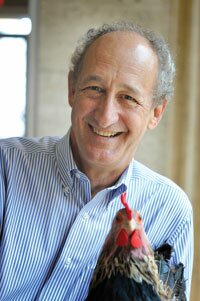FACETIME- Nitro man: Galloway's 'cascade' flows with cash

.
PHOTO BY JEN FARIELLO
On the door to UVA prof Jim Galloway's office in Clark Hall hangs a giant schnoz– "a life-size replica of my nose," he jokes. The guy who recently won the $100,000 Tyler Prize– the Nobel of environmental studies– has his office window open, and let's just say that's not helping reduce the nitrogen footprint.
"I need fresh air," explains Galloway, 63, who wears a sweater all summer.
Well, okay. This is after he explains the nitrogen cascade– how nitrogen emissions from cars contribute to smog that turns to acid rain that kills fish in river, makes dead zones in the oceans, decreases ozone– and voila!– contributes to the greenhouse effect.
Even worse is the nitrogen in fertilizer. "Only 15 percent of that nitrogen enters the human mouth," says Galloway. 'The rest is lost during the food production process." And the nitrogen footprint of a pound of hamburger is huge.
He got into nitrogen in the '70s thanks to a letter from a Cornell researcher who needed someone to "work on this thing called acid rain," Galloway explains. He went from being a poor pottery thrower and natural foods storekeeper in Lexington in 1972 ("Not a lot of people were eating soybeans then," he notes dryly) to the job as a post-doctoral fellow at Cornell. "In one day I bought my first-ever new house and car," he says.
Maryland-born Galloway grew up in southern California, and got his PhD in chemistry from UC San Diego. While an undergrad at Whittier College (Richard Nixon's alma mater), he wanted to be a pediatrician, but there was one problem: "I wasn't sure I could deal with sick children."
When he decided to go to grad school in chemistry instead, his father responded, "Thank God. You've just saved thousands of lives."
"The late '60s were a great time to be in school in California," says Galloway, noting that it so astounding to finish a doctorate and bolt for the hippy-dippy wilds of Virginia to run a health food store.
"I did natural foods and pottery because I was really tired of school," he acknowledges. "I needed a break."
The biggest misperception people have about the environmental hazards of nitrogen or carbon is that it's too complicated. "I respond, there's lots an individual can do," Galloway says.
He lists use of public transportation instead of cars, a balanced diet with less beef and more chicken and fish, and houses where the thermostat isn't as warm in the winter or cold in the summer. (Ahem. Could that open window be an indicator the thermostat in Clark Hall is set too low?)
Galloway is pragmatic about how much people can reasonably be expected to do. "We can't become hermits scavenging nuts and berries," he says.
"He clearly is one of the most creative thinkers in the field of biogeochemistry," says colleague George Hornberger, who applauds, for instance, Galloway's international ties with the Chinese. "When you work on a global scale, you can't just sit at your desk and work on your own."
In April Galloway and his family were at the Beverly Hills Four Seasons– where the nitrogen footprint is "off the scale" but the food magnificent– for him to collect his no-strings-attached share of the Tyler Prize, which he used to set up a research fund at UVA.
He offers another suggestion for reducing the need for fertilizers that jack up the nitrogen cascade. "If this country overnight decided not to waste any foods, we'd reduce by 25 percent the fertilizer needed."
Clean your plate.
#